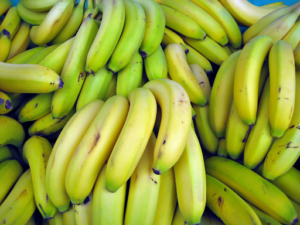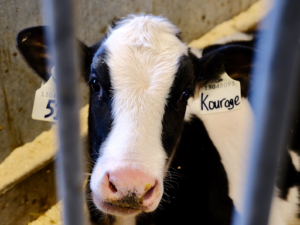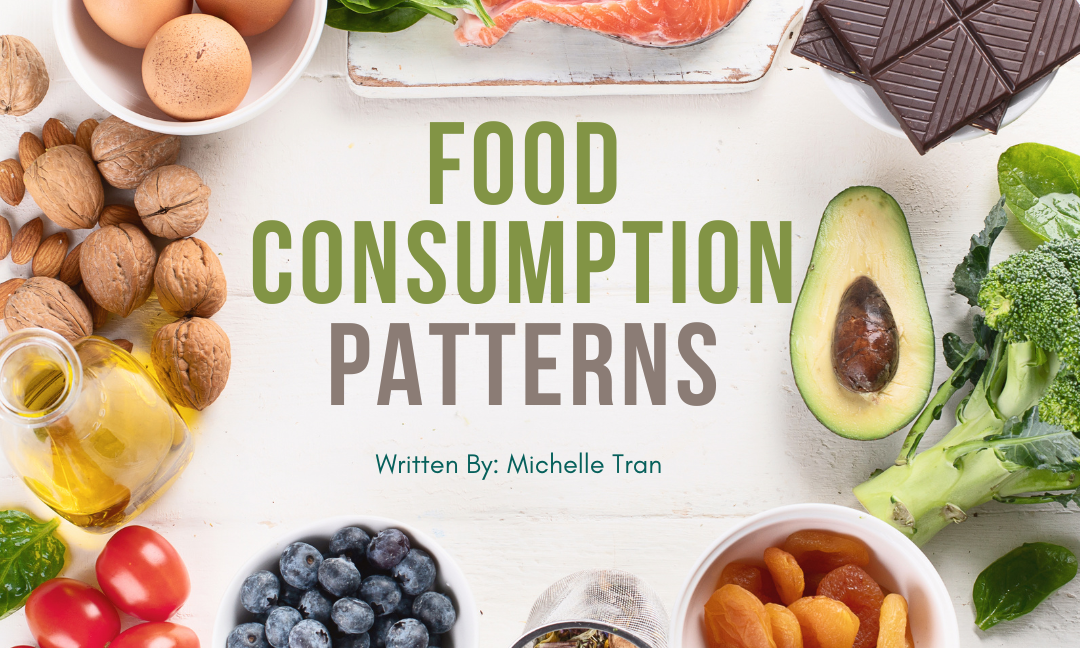Written by Michelle Tran
Edited by Kiritika Rana
Designed by Eshika Hiremath
Published by Kiritika Rana
Over the years, Canadians have adapted to new eating habits and consumption patterns. Many of the previous consumption patterns have evolved into better, healthier, and safer diets for Canadians with the help of diversity and development.
According to a CBC report by Roberto Rocha (2018), “Canadians are eating less beef, drinking less milk and soft drinks, and eating more flour-based carbs than they did 50 years ago.“
Consumption patterns have been evolving as the Canadian population also evolves. As the area becomes more diverse, different cultures and ethnicities can represent different types of foods around the world. Food availability also plays a big role in what Canadians eat as consumption patterns reflect consumer trends.
Fruits, Vegetables, and Grains
Research has shown that Canadians have been getting the majority of their carbohydrates from potatoes, while wheat is coming in at second place. However, Canadians have been eating fewer potatoes compared to the 1930s (Rocha, 2018).
Cultural shares of food from Asia have changed carbohydrate statistics, as in 2004, rice overtook corn as being the third most common source of carbohydrates.
 As for fruits, bananas overtook apples despite them being difficult to grow.
As for fruits, bananas overtook apples despite them being difficult to grow.
How did bananas overtake the amazing fruit we know as apples?
Well, a couple of factors came into play such as cost, production, convenience, and globalization.
Bananas are easier to transport, are in high demand, and are cheap. These three factors helped bananas to overrule against apples despite it being the most plentiful food in Canada. Bananas always have their cover, so food safety is never an issue. It’s portable and able to eat quickly.
It is also possible the aging Canadian population plays some factors, as apples are harder to eat among older people.
Meat and Alternatives
 There was also a slow decline in red meat which has been shown to decrease in consumers’ patterns over the years. Despite meat being the main source of protein, many have shifted away from meat as there have been many environmental and health warnings surrounding meat. Prices of meat have also been impacted due to inflation which has pushed many people away from the food source (Rocha, 2018).
There was also a slow decline in red meat which has been shown to decrease in consumers’ patterns over the years. Despite meat being the main source of protein, many have shifted away from meat as there have been many environmental and health warnings surrounding meat. Prices of meat have also been impacted due to inflation which has pushed many people away from the food source (Rocha, 2018).
Not all meats are decreasing though, chicken and turkey sales have been on the rise, as chicken is not only cheap but supply-managed and high quality.
Dairy
 All kinds of cow milk have surprisingly decreased, as it is being replaced with alternatives like soy and almond milk. Many have advocated that “we’re not cows, we’re not supposed to be drinking milk” (Rocha, 2018). Many milk byproducts have had a reported increase, shifting away from the primary cow milk source.
All kinds of cow milk have surprisingly decreased, as it is being replaced with alternatives like soy and almond milk. Many have advocated that “we’re not cows, we’re not supposed to be drinking milk” (Rocha, 2018). Many milk byproducts have had a reported increase, shifting away from the primary cow milk source.
Canadians are also consuming a variety of cheeses, with the spike in weight being eight kilograms available per person, which compared to before, was 0.6 kg in 1960.
Sweets and Sugar

Many have shifted away from sugar. From 1999 to 2004, soda was popular among Canadians and increased trends by a ton along with other beverages. (Rocha, 2018). However, as the years go by with more information revealing the damages sugar causes, soft drinks and soda have decreased among individuals.
What Hasn’t Changed?
Vegetables used in salads have seen very little changes in Canadian food trends. Tomatoes, carrots, lettuce and onions have all been in constant shape within consumption patterns, and not much has changed over the years (Rocha, 2018).
Canada’s Food Guide
Canada’s food guide originated in 1942. Our most recent one was released in 2019 and ever since Canada has followed that food guide as it was the most adaptable and inclusive one yet. Before, Canada’s food guide expressed their foods with particular servings and measurements. An amazing change to the food guide is the inclusiveness with no servings or measurements, and only recommendations of food to stay physically active every day. The food guide was also tailored to First Nations, Inuit and Métis food, which is a great change of inclusivity (Government of Canada, 2007).
So What Exactly Is Happening To The Consumption Patterns In Canada?
Canadian food trends have adapted drastically over the past century, there have been both pros and cons to the adaptation but the real reason why our consumption patterns change is so that we can adapt to Canada’s changes in the economics of food. We all are aware of the inflation that has risen in Canada, many Canadians are having to spend less on their food so that they can save money. Not only is this concerning, but the cost of living in Canada is making families and individuals change their grocery plans to save money.
“According to Statistics Canada, food and grocery stores played a significant part in this inflation, with prices in this sector increasing by 11.4 percent.” (Galler, 2022).
All Canadians should be able to have access to enough healthy food, allowing for a healthy lifestyle, yet the cost of living has set a barrier to reaching that goal for lots of Canadians.
 Food banks are becoming overwhelmed with the number of individuals coming in, which concludes that although consumption patterns allow Canadians to be more budget-friendly, it adds extra strain on the economy and lives of individuals living in Canada.
Food banks are becoming overwhelmed with the number of individuals coming in, which concludes that although consumption patterns allow Canadians to be more budget-friendly, it adds extra strain on the economy and lives of individuals living in Canada.
References
Breakingpic. (2014, January 21). File:Soda Cans Pexels Breakingpic 3008.jpg.
Wikimedia Commons. https://commons.wikimedia.org/wiki/File:Soda_Cans_Pexels_Breakingpic_3008.jpg
Budimaier, L. (n.d.). Meat Beef Free Stock Image. StockSnap. https://stocksnap.io/photo/meat-beef-HRVOVU93ZA
Clifford, J. (2010, August 16). File:Kourage (47320922591).jpg. Wikimedia Commons. https://commons.wikimedia.org/wiki/File:Bananas.JPG
Fradella, A. (2022, November 16). Behind the Numbers: What’s Causing Growth in Food Prices. Statistics Canada. https://www150.statcan.gc.ca/n1/pub/62f0014m/62f0014m2022014-eng.htm
Galler, G. (2022, November 1). Why are Canadians changing their eating habits? New Food Magazine. https://www.newfoodmagazine.com/news/169541/why-are-canadians-changing-their-eating-habits/
Government of Canada. (2007, April 11). Eating Well with Canada’s Food Guide – First Nations, Inuit and Métis. Canada.ca. Retrieved November 9, 2023, from https://www.canada.ca/en/health-canada/services/canada-food-guide/about/history-food-guide/eating-well-canada-food-guide-first-nations-inuit-metis.html
Marlith. (2010, August 16). File:Banana.JPG. Wikimedia Commons. https://commons.wikimedia.org/wiki/File:Bananas.JPG
Roberto, R. (2018, July 17). Here’s what 50 years of food supply data says about Canada’s eating habits. CBC News. https://www.cbc.ca/news/canada/montreal/canada-food-trends
Witham, T. (n.d.). U.S. Department of Agriculture. https://www.rawpixel.com/image/9654484/image-face-person-laptop

